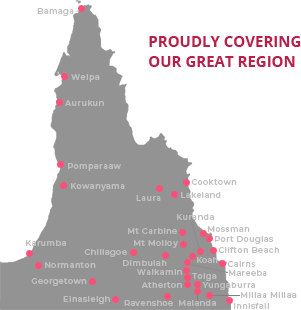General News
13 June, 2025
Walking plans pose challenge for TRC
A MASSIVE challenge to make Atherton and Malanda much safer to walk around and accessible for those with mobility challenges awaits Tablelands Regional Council, with an action plan detailing more than 160 projects that will take years to deliver.

The walking network plans for the two towns were funded by the Department of Transport and Main Roads and developed using findings from a Spinal Life Australia report which identified accessibility barriers, the Principal Cycle Network Plan, council’s customer requests, and a community survey.
The survey was aimed at finding out how current footpaths were used, what challenges they presented to users, and what footpaths were needed, with 70% of respondents identifying missing links to existing footpaths, substandard or narrow footpath widths, and non-compliant crossing ramps.
The action plans contain 162 projects of varied importance needed to ensure that pedestrians and cyclists have better protection and ease of access.
The projects range from missing footpath links, the upgrade and renewal of narrow and non-compliant footpaths and crossing improvements.
The Spinal Life Australia report detailed what works it believed were necessary in Atherton’s main district precinct, including the need to modify the pedestrian crossing in Main Street to enable those with mobility devices to use it.
“While pathways along Main Street are largely navigable, barriers are frequent and significant, especially at both ends of the main business centre,” the report stated.
“A noticeable lack of connection exists between the visitor information centre and adjacent stores on Herberton Road, as well as between the post office and adjacent shops, creating significant navigation barriers.
“The pathway network at the intersection of Main Street, Railway Lane and Cook Street is notably disconnected.”
The report also listed areas of concern at Malanda including the crossing at James Street and Churchill Avenue which it described as “in disrepair”.
Also noted was the lack of an accessible path from the main business centre to the Malanda Showground.
Out of the 162 actions contained in the Atherton and Malanda plans, two of the key areas listed as “essential” to undertake are:
• From the Atherton CBD to Atherton Hospital – inconsistent footpath widths, non-compliant kerb ramps along Jack Street and no defined crossing point along Louise Street makes it difficult for users to access the Atherton Hospital; and
• Malanda CBD to Malanda State High School – missing link on Patrick Street from Belson Street to James Street, no connectivity to Malanda CBD from Malanda SHS along the western side of Patrick Street.
There are 51 actions that are listed as “essential” for well-used areas like Roberts, Mabel and Lloyd Streets in Atherton and Catherine and Elizabeth Streets in Malanda.
Each action item in the plans has been designated a rank, timing of works, responsible organisation and estimated cost band.
“The timing of the works is designated by several different variables, for example, crossing improvements are prioritised as an immediate action as these improvements ensure continuity and connectivity throughout the existing network,” a report to council stated.
“Missing links (in footpaths) have been prioritised over narrow path renewals on the basis that connectivity to existing networks takes priority over width.”
Council can apply for funding from DTMR for some of the projects that have to be done, and other funding streams but it is understood the action plans will take years to fully deliver.


